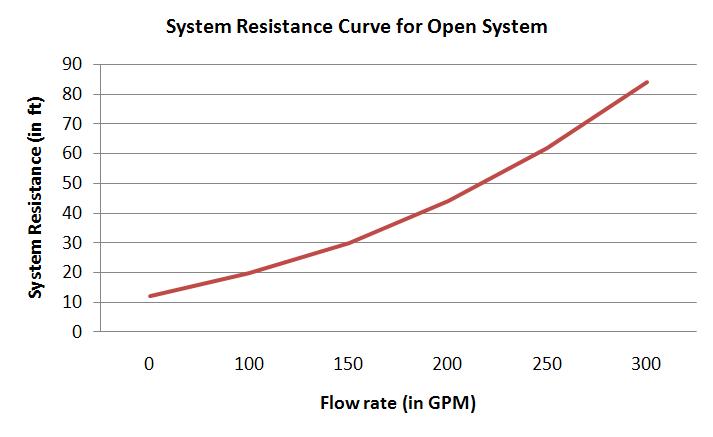Refer the concept of the system resistance curve from my previous article for better understanding this article.
You will find an important equation there:
- Total system resistance = Frictional resistance + Resistance due to static head (height difference) + Resistance due to pressure head (pressure difference) + Resistance due to velocity (typically neglected)…………………Eq.1
The above Eq.1 can be used for fan and pump system head curve calculation for the closed as well as the open systems. I already discussed how to draw a system performance or resistance curve for a closed system; I will discuss an example problem for an open system in this article.
Example Problem for Plotting System Resistance Curve for an Open System
Refer the schematics of the below open fluid handling piping system and plot the system resistance curve for the water system.

It has been found from calculation that the system exerts 50 ft (water column) of frictional resistance head for a flow rate of 250 GPM.
Solution:
For solving the above problem, we have to use the Eq.1. Let’s try to find out the right hand side quantities of the Eq.1.
Resistance due to static head = 4 ft (the height difference between the suction and the discharge tank)
Resistance due to pressure head = 8 ft (the pressure difference between the discharge and suction tank)
Resistance due to velocity =0 (negligible)
Resistance due to friction @250 GPM flow rate= 50 ft (Given)
Two important piping or HVAC system fundamental rules to be remembered:
- 1. The frictional resistance is proportional to the square of the flow rate.
- 2. The values of the resistance due to static head and pressure head remain fixed with respect to the flow rate.
The importance of the rule-2 is: we can use the same values for the resistance due to static head and pressure head for any flow rate while calculating the different data points.
Data points calculations:
1. For flow rate = 250 GPM
Total system resistance =50 ft (Frictional resistance given) + 4 ft (resistance due to static head) + 8 ft (resistance due to pressure head) =62 ft
2. For flow rate = 250*1.2=300 GPM
Total system resistance =50 *1.2*1.2 ft (Frictional resistance using rule-1) + 4 ft (resistance due to static head) + 8 ft (resistance due to pressure head) =84 ft
3. For flow rate = 250*0.8=200 GPM
Total system resistance =50 *0.8*0.8 ft (Frictional resistance using rule-1) + 4 ft (resistance due to static head) + 8 ft (resistance due to pressure head) =44 ft
4. For flow rate = 250*0.6=150 GPM
Total system resistance =50 *0.6*0.6 ft (Frictional resistance using rule-1) + 4 ft (resistance due to static head) + 8 ft (resistance due to pressure head) =30 ft
5. For flow rate = 250*0.4=100 GPM
Total system resistance =50 *0.4*0.4 ft (Frictional resistance using rule-1) + 4 ft (resistance due to static head) + 8 ft (resistance due to pressure head) =20 ft
6. For flow rate = 250*0=0 GPM
Total system resistance =50 *0*0 ft (Frictional resistance using rule-1) + 4 ft (resistance due to static head) + 8 ft (resistance due to pressure head) =12 ft
Now, we are ready to plot the system resistance curve for the above six points (1 given + 5 derived) by putting the flow rate along the X axis and the total system resistance along the Y axis. The final system performance curve (pump system head curve to be precise) for open system looks like below:

I the next article I will discuss how to use system curve and pump curve for selecting suitable pump.
Hi, I am Shibashis, a blogger by passion and an engineer by profession. I have written most of the articles for mechGuru.com. For more than a decades i am closely associated with the engineering design/manufacturing simulation technologies. I am a self taught code hobbyist, presently in love with Python (Open CV / ML / Data Science /AWS -3000+ lines, 400+ hrs. )

Too good man
man your site is really really informative and practically helpful